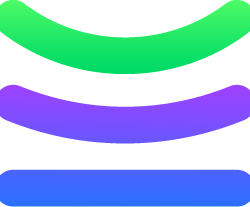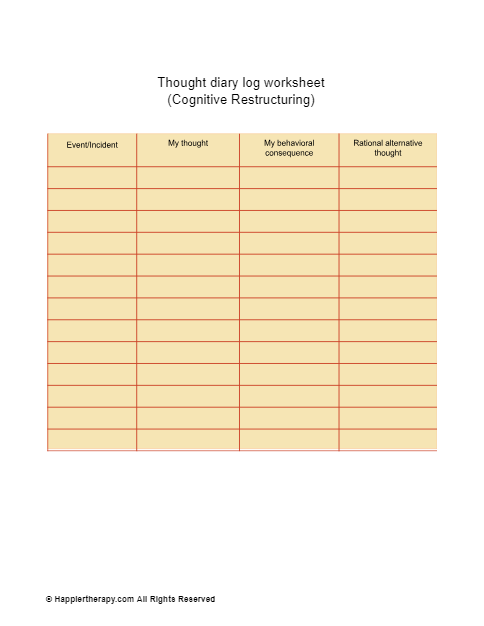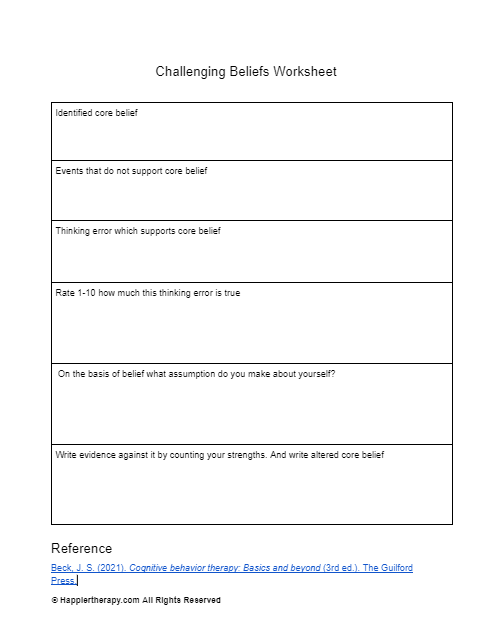Cognitive Distortions: Blaming Worksheet
Premium Content
Access this worksheet and 2,500 mental health worksheets. Cancel anytime
According to the American Psychological Association (APA), cognitive distortion can be defined as faulty or inaccurate thinking, perception or belief. (APA, © 2022) Often at times, cognitive distortions fuel our anxiety and increase our misery.
Unlock deeper healing — upgrade to Premium now!
Customizable and fillable worksheets
Rights to alter the worksheets
Over 2000 worksheets
Support HappierTherapy
There are a number of cognitive distortions identified in Cognitive Behavioral Therapy, the most common include:
- All-or-Nothing Thinking/ Polarized Thinking
- Overgeneralization
- Mental Filters
- Catastrophizing/ Magnification or Minimization
- Mind Reading/ Jumping to Conclusions
- Predicting the Future
- Emotional Reasoning
- “Shoulds” Statements
- Labelling
10. Personalization and Blame
This particular worksheet will focus on: BLAMING.
What Are The Theories Behind This Worksheet?
Blaming is one of the cognitive distortions whereby you assign guilt or responsibility for something that happened or for how you feel towards others. (Therapy Now SF, © 2021)
Often at times, the responsibilities assigned to blaming are usually negative acts. When our brains subconsciously switch to blaming, what occurs next is an array of negative emotional conditions such as anger, fear, guilt, resentment, frustration, anxiety et al.
When we blame others, we are expressing: how we feel, what we think, and our negative actions.
Example: An alcoholic will tend to blame their abusive parent for his/her drug problem.
People who battle with blaming tend to be suffering from traumatic experiences (physical, sexual, emotional), anxiety, depression, panic disorder etc.
Blaming as a cognitive distortion can also be referred to as Personalization and Blame.
How Will This Worksheet Help You?
This worksheet is targeted to help individuals:
- Identify and stop unhelpful thinking patterns.
- Learn to own your emotions and be accountable for your actions.
- Consider seeking professional help in order to work towards your shortcomings without degrading yourself or avoiding holding yourself accountable.
Blaming is a generalized way of avoiding dealing with problems. However, healing begins when we understand the interconnectedness between our thoughts, emotions and actions.
How Should You Use This Worksheet?
To begin with, learn how to forgive yourself and others. When we let go of blame, we are in a better position to move forward and work on being the best versions of ourselves.
A good way of starting this recovery journey is to be brutally honest and give clear reasons as to why you blame yourself, others or situations/ circumstances. This will start teaching you how to own your emotions and be accountable for your actions.
This worksheet can also be used daily as a self-evaluation kit.
Was this helpful?
References
1.-
American Psychological Association. (© 2022). Cognitive Distortion. Available at:
https://dictionary.apa.org/cognitive-distortion. [Accessed October 05, 2022].
2.-
Therapy Now SF. (© 2021). Blaming: One of the most common Cognitive Distortions. Available at: https://www.therapynowsf.com/blog/blaming-one-of-the-most-common-cognitive-distortions. [Accessed October 12, 2022].
 By
By


